PPMP20011: Consolidated Portfolio of Project Management & Engagement
VerifiedAdded on 2023/06/11
|9
|2762
|196
Portfolio
AI Summary
This consolidated portfolio provides a comprehensive overview of project management principles, emphasizing the critical roles of stakeholder engagement, commercial negotiation, and conflict management within organizations. It includes reflections on learning outcomes from various lectures, supported by evidence and practical insights. The portfolio addresses commercial planning, the significance of managing stakeholder relationships, the role of project managers in commercial negotiations, and the importance of effective communication. It further differentiates between engagement management and project management, highlighting the need for cooperative stakeholders and well-maintained relationships to ensure project success. The document emphasizes the use of strategies for conflict resolution and the application of project management standards to enhance project efficiency and outcomes. Desklib is your go-to for more solved assignments and study resources.

Running head: PORTFOLIO
PORTFOLIO
Name of the Student
Name of the University
Author note
PORTFOLIO
Name of the Student
Name of the University
Author note
Paraphrase This Document
Need a fresh take? Get an instant paraphrase of this document with our AI Paraphraser
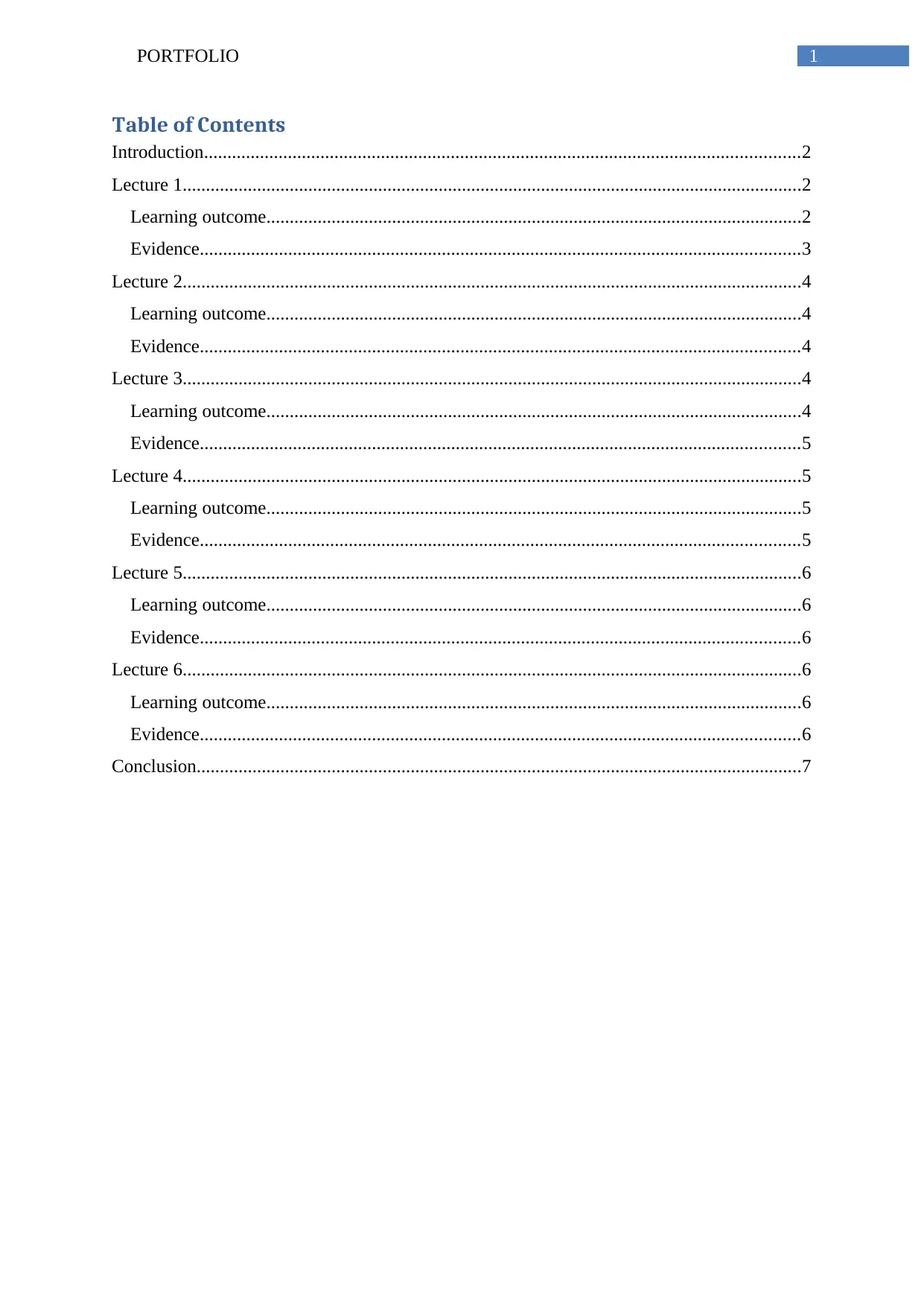
1PORTFOLIO
Table of Contents
Introduction................................................................................................................................2
Lecture 1.....................................................................................................................................2
Learning outcome...................................................................................................................2
Evidence.................................................................................................................................3
Lecture 2.....................................................................................................................................4
Learning outcome...................................................................................................................4
Evidence.................................................................................................................................4
Lecture 3.....................................................................................................................................4
Learning outcome...................................................................................................................4
Evidence.................................................................................................................................5
Lecture 4.....................................................................................................................................5
Learning outcome...................................................................................................................5
Evidence.................................................................................................................................5
Lecture 5.....................................................................................................................................6
Learning outcome...................................................................................................................6
Evidence.................................................................................................................................6
Lecture 6.....................................................................................................................................6
Learning outcome...................................................................................................................6
Evidence.................................................................................................................................6
Conclusion..................................................................................................................................7
Table of Contents
Introduction................................................................................................................................2
Lecture 1.....................................................................................................................................2
Learning outcome...................................................................................................................2
Evidence.................................................................................................................................3
Lecture 2.....................................................................................................................................4
Learning outcome...................................................................................................................4
Evidence.................................................................................................................................4
Lecture 3.....................................................................................................................................4
Learning outcome...................................................................................................................4
Evidence.................................................................................................................................5
Lecture 4.....................................................................................................................................5
Learning outcome...................................................................................................................5
Evidence.................................................................................................................................5
Lecture 5.....................................................................................................................................6
Learning outcome...................................................................................................................6
Evidence.................................................................................................................................6
Lecture 6.....................................................................................................................................6
Learning outcome...................................................................................................................6
Evidence.................................................................................................................................6
Conclusion..................................................................................................................................7
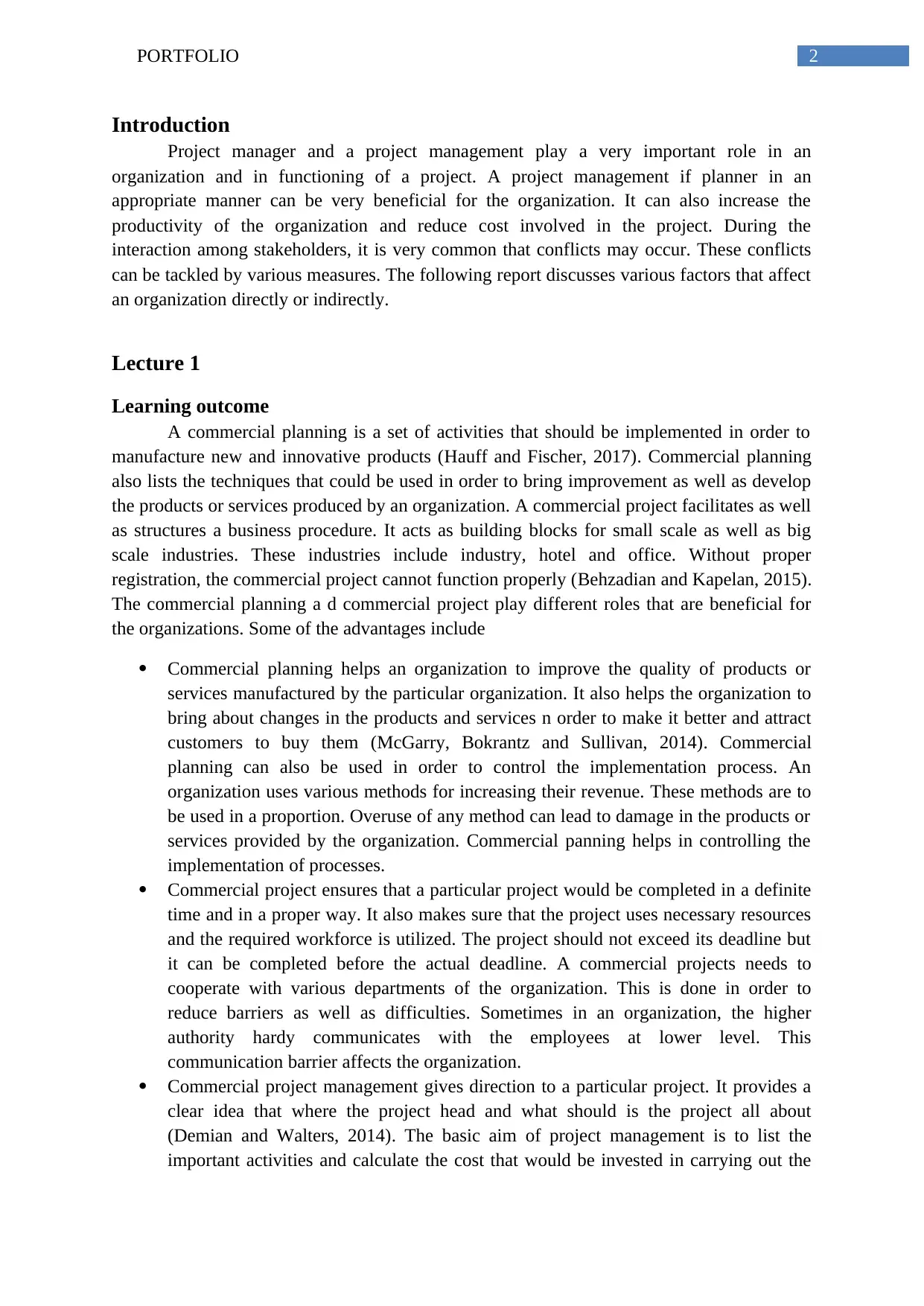
2PORTFOLIO
Introduction
Project manager and a project management play a very important role in an
organization and in functioning of a project. A project management if planner in an
appropriate manner can be very beneficial for the organization. It can also increase the
productivity of the organization and reduce cost involved in the project. During the
interaction among stakeholders, it is very common that conflicts may occur. These conflicts
can be tackled by various measures. The following report discusses various factors that affect
an organization directly or indirectly.
Lecture 1
Learning outcome
A commercial planning is a set of activities that should be implemented in order to
manufacture new and innovative products (Hauff and Fischer, 2017). Commercial planning
also lists the techniques that could be used in order to bring improvement as well as develop
the products or services produced by an organization. A commercial project facilitates as well
as structures a business procedure. It acts as building blocks for small scale as well as big
scale industries. These industries include industry, hotel and office. Without proper
registration, the commercial project cannot function properly (Behzadian and Kapelan, 2015).
The commercial planning a d commercial project play different roles that are beneficial for
the organizations. Some of the advantages include
Commercial planning helps an organization to improve the quality of products or
services manufactured by the particular organization. It also helps the organization to
bring about changes in the products and services n order to make it better and attract
customers to buy them (McGarry, Bokrantz and Sullivan, 2014). Commercial
planning can also be used in order to control the implementation process. An
organization uses various methods for increasing their revenue. These methods are to
be used in a proportion. Overuse of any method can lead to damage in the products or
services provided by the organization. Commercial panning helps in controlling the
implementation of processes.
Commercial project ensures that a particular project would be completed in a definite
time and in a proper way. It also makes sure that the project uses necessary resources
and the required workforce is utilized. The project should not exceed its deadline but
it can be completed before the actual deadline. A commercial projects needs to
cooperate with various departments of the organization. This is done in order to
reduce barriers as well as difficulties. Sometimes in an organization, the higher
authority hardy communicates with the employees at lower level. This
communication barrier affects the organization.
Commercial project management gives direction to a particular project. It provides a
clear idea that where the project head and what should is the project all about
(Demian and Walters, 2014). The basic aim of project management is to list the
important activities and calculate the cost that would be invested in carrying out the
Introduction
Project manager and a project management play a very important role in an
organization and in functioning of a project. A project management if planner in an
appropriate manner can be very beneficial for the organization. It can also increase the
productivity of the organization and reduce cost involved in the project. During the
interaction among stakeholders, it is very common that conflicts may occur. These conflicts
can be tackled by various measures. The following report discusses various factors that affect
an organization directly or indirectly.
Lecture 1
Learning outcome
A commercial planning is a set of activities that should be implemented in order to
manufacture new and innovative products (Hauff and Fischer, 2017). Commercial planning
also lists the techniques that could be used in order to bring improvement as well as develop
the products or services produced by an organization. A commercial project facilitates as well
as structures a business procedure. It acts as building blocks for small scale as well as big
scale industries. These industries include industry, hotel and office. Without proper
registration, the commercial project cannot function properly (Behzadian and Kapelan, 2015).
The commercial planning a d commercial project play different roles that are beneficial for
the organizations. Some of the advantages include
Commercial planning helps an organization to improve the quality of products or
services manufactured by the particular organization. It also helps the organization to
bring about changes in the products and services n order to make it better and attract
customers to buy them (McGarry, Bokrantz and Sullivan, 2014). Commercial
planning can also be used in order to control the implementation process. An
organization uses various methods for increasing their revenue. These methods are to
be used in a proportion. Overuse of any method can lead to damage in the products or
services provided by the organization. Commercial panning helps in controlling the
implementation of processes.
Commercial project ensures that a particular project would be completed in a definite
time and in a proper way. It also makes sure that the project uses necessary resources
and the required workforce is utilized. The project should not exceed its deadline but
it can be completed before the actual deadline. A commercial projects needs to
cooperate with various departments of the organization. This is done in order to
reduce barriers as well as difficulties. Sometimes in an organization, the higher
authority hardy communicates with the employees at lower level. This
communication barrier affects the organization.
Commercial project management gives direction to a particular project. It provides a
clear idea that where the project head and what should is the project all about
(Demian and Walters, 2014). The basic aim of project management is to list the
important activities and calculate the cost that would be invested in carrying out the
⊘ This is a preview!⊘
Do you want full access?
Subscribe today to unlock all pages.

Trusted by 1+ million students worldwide
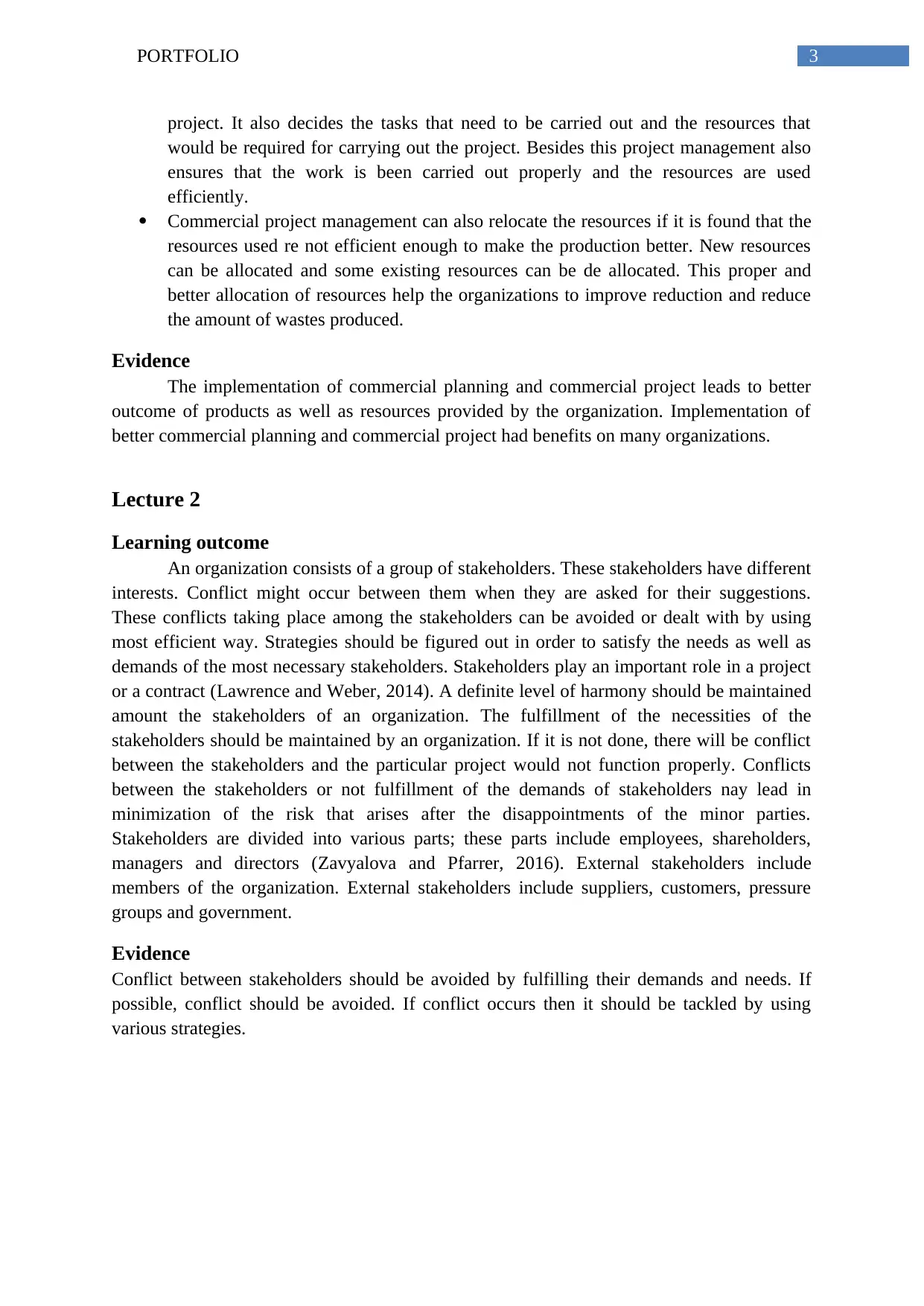
3PORTFOLIO
project. It also decides the tasks that need to be carried out and the resources that
would be required for carrying out the project. Besides this project management also
ensures that the work is been carried out properly and the resources are used
efficiently.
Commercial project management can also relocate the resources if it is found that the
resources used re not efficient enough to make the production better. New resources
can be allocated and some existing resources can be de allocated. This proper and
better allocation of resources help the organizations to improve reduction and reduce
the amount of wastes produced.
Evidence
The implementation of commercial planning and commercial project leads to better
outcome of products as well as resources provided by the organization. Implementation of
better commercial planning and commercial project had benefits on many organizations.
Lecture 2
Learning outcome
An organization consists of a group of stakeholders. These stakeholders have different
interests. Conflict might occur between them when they are asked for their suggestions.
These conflicts taking place among the stakeholders can be avoided or dealt with by using
most efficient way. Strategies should be figured out in order to satisfy the needs as well as
demands of the most necessary stakeholders. Stakeholders play an important role in a project
or a contract (Lawrence and Weber, 2014). A definite level of harmony should be maintained
amount the stakeholders of an organization. The fulfillment of the necessities of the
stakeholders should be maintained by an organization. If it is not done, there will be conflict
between the stakeholders and the particular project would not function properly. Conflicts
between the stakeholders or not fulfillment of the demands of stakeholders nay lead in
minimization of the risk that arises after the disappointments of the minor parties.
Stakeholders are divided into various parts; these parts include employees, shareholders,
managers and directors (Zavyalova and Pfarrer, 2016). External stakeholders include
members of the organization. External stakeholders include suppliers, customers, pressure
groups and government.
Evidence
Conflict between stakeholders should be avoided by fulfilling their demands and needs. If
possible, conflict should be avoided. If conflict occurs then it should be tackled by using
various strategies.
project. It also decides the tasks that need to be carried out and the resources that
would be required for carrying out the project. Besides this project management also
ensures that the work is been carried out properly and the resources are used
efficiently.
Commercial project management can also relocate the resources if it is found that the
resources used re not efficient enough to make the production better. New resources
can be allocated and some existing resources can be de allocated. This proper and
better allocation of resources help the organizations to improve reduction and reduce
the amount of wastes produced.
Evidence
The implementation of commercial planning and commercial project leads to better
outcome of products as well as resources provided by the organization. Implementation of
better commercial planning and commercial project had benefits on many organizations.
Lecture 2
Learning outcome
An organization consists of a group of stakeholders. These stakeholders have different
interests. Conflict might occur between them when they are asked for their suggestions.
These conflicts taking place among the stakeholders can be avoided or dealt with by using
most efficient way. Strategies should be figured out in order to satisfy the needs as well as
demands of the most necessary stakeholders. Stakeholders play an important role in a project
or a contract (Lawrence and Weber, 2014). A definite level of harmony should be maintained
amount the stakeholders of an organization. The fulfillment of the necessities of the
stakeholders should be maintained by an organization. If it is not done, there will be conflict
between the stakeholders and the particular project would not function properly. Conflicts
between the stakeholders or not fulfillment of the demands of stakeholders nay lead in
minimization of the risk that arises after the disappointments of the minor parties.
Stakeholders are divided into various parts; these parts include employees, shareholders,
managers and directors (Zavyalova and Pfarrer, 2016). External stakeholders include
members of the organization. External stakeholders include suppliers, customers, pressure
groups and government.
Evidence
Conflict between stakeholders should be avoided by fulfilling their demands and needs. If
possible, conflict should be avoided. If conflict occurs then it should be tackled by using
various strategies.
Paraphrase This Document
Need a fresh take? Get an instant paraphrase of this document with our AI Paraphraser
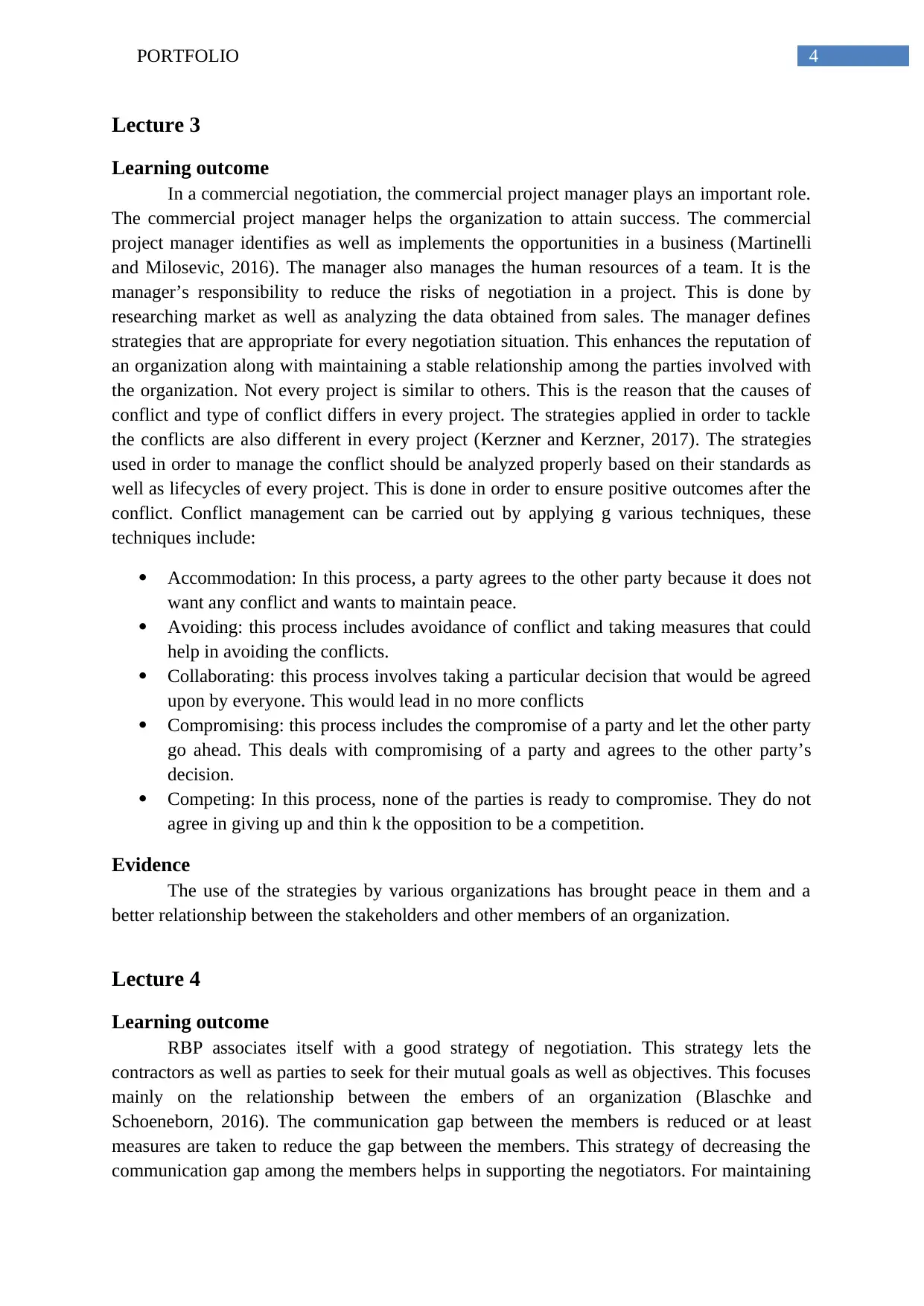
4PORTFOLIO
Lecture 3
Learning outcome
In a commercial negotiation, the commercial project manager plays an important role.
The commercial project manager helps the organization to attain success. The commercial
project manager identifies as well as implements the opportunities in a business (Martinelli
and Milosevic, 2016). The manager also manages the human resources of a team. It is the
manager’s responsibility to reduce the risks of negotiation in a project. This is done by
researching market as well as analyzing the data obtained from sales. The manager defines
strategies that are appropriate for every negotiation situation. This enhances the reputation of
an organization along with maintaining a stable relationship among the parties involved with
the organization. Not every project is similar to others. This is the reason that the causes of
conflict and type of conflict differs in every project. The strategies applied in order to tackle
the conflicts are also different in every project (Kerzner and Kerzner, 2017). The strategies
used in order to manage the conflict should be analyzed properly based on their standards as
well as lifecycles of every project. This is done in order to ensure positive outcomes after the
conflict. Conflict management can be carried out by applying g various techniques, these
techniques include:
Accommodation: In this process, a party agrees to the other party because it does not
want any conflict and wants to maintain peace.
Avoiding: this process includes avoidance of conflict and taking measures that could
help in avoiding the conflicts.
Collaborating: this process involves taking a particular decision that would be agreed
upon by everyone. This would lead in no more conflicts
Compromising: this process includes the compromise of a party and let the other party
go ahead. This deals with compromising of a party and agrees to the other party’s
decision.
Competing: In this process, none of the parties is ready to compromise. They do not
agree in giving up and thin k the opposition to be a competition.
Evidence
The use of the strategies by various organizations has brought peace in them and a
better relationship between the stakeholders and other members of an organization.
Lecture 4
Learning outcome
RBP associates itself with a good strategy of negotiation. This strategy lets the
contractors as well as parties to seek for their mutual goals as well as objectives. This focuses
mainly on the relationship between the embers of an organization (Blaschke and
Schoeneborn, 2016). The communication gap between the members is reduced or at least
measures are taken to reduce the gap between the members. This strategy of decreasing the
communication gap among the members helps in supporting the negotiators. For maintaining
Lecture 3
Learning outcome
In a commercial negotiation, the commercial project manager plays an important role.
The commercial project manager helps the organization to attain success. The commercial
project manager identifies as well as implements the opportunities in a business (Martinelli
and Milosevic, 2016). The manager also manages the human resources of a team. It is the
manager’s responsibility to reduce the risks of negotiation in a project. This is done by
researching market as well as analyzing the data obtained from sales. The manager defines
strategies that are appropriate for every negotiation situation. This enhances the reputation of
an organization along with maintaining a stable relationship among the parties involved with
the organization. Not every project is similar to others. This is the reason that the causes of
conflict and type of conflict differs in every project. The strategies applied in order to tackle
the conflicts are also different in every project (Kerzner and Kerzner, 2017). The strategies
used in order to manage the conflict should be analyzed properly based on their standards as
well as lifecycles of every project. This is done in order to ensure positive outcomes after the
conflict. Conflict management can be carried out by applying g various techniques, these
techniques include:
Accommodation: In this process, a party agrees to the other party because it does not
want any conflict and wants to maintain peace.
Avoiding: this process includes avoidance of conflict and taking measures that could
help in avoiding the conflicts.
Collaborating: this process involves taking a particular decision that would be agreed
upon by everyone. This would lead in no more conflicts
Compromising: this process includes the compromise of a party and let the other party
go ahead. This deals with compromising of a party and agrees to the other party’s
decision.
Competing: In this process, none of the parties is ready to compromise. They do not
agree in giving up and thin k the opposition to be a competition.
Evidence
The use of the strategies by various organizations has brought peace in them and a
better relationship between the stakeholders and other members of an organization.
Lecture 4
Learning outcome
RBP associates itself with a good strategy of negotiation. This strategy lets the
contractors as well as parties to seek for their mutual goals as well as objectives. This focuses
mainly on the relationship between the embers of an organization (Blaschke and
Schoeneborn, 2016). The communication gap between the members is reduced or at least
measures are taken to reduce the gap between the members. This strategy of decreasing the
communication gap among the members helps in supporting the negotiators. For maintaining
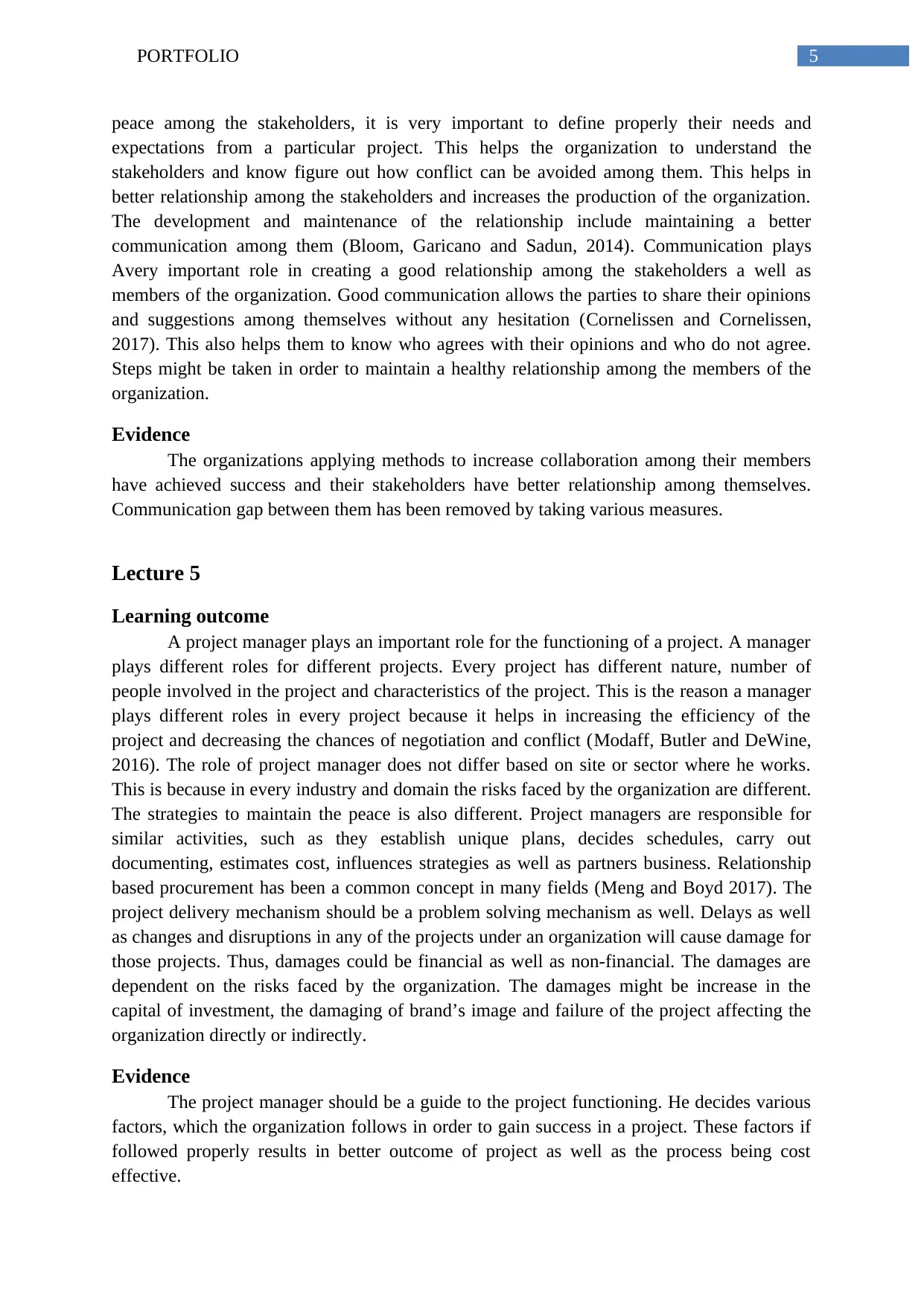
5PORTFOLIO
peace among the stakeholders, it is very important to define properly their needs and
expectations from a particular project. This helps the organization to understand the
stakeholders and know figure out how conflict can be avoided among them. This helps in
better relationship among the stakeholders and increases the production of the organization.
The development and maintenance of the relationship include maintaining a better
communication among them (Bloom, Garicano and Sadun, 2014). Communication plays
Avery important role in creating a good relationship among the stakeholders a well as
members of the organization. Good communication allows the parties to share their opinions
and suggestions among themselves without any hesitation (Cornelissen and Cornelissen,
2017). This also helps them to know who agrees with their opinions and who do not agree.
Steps might be taken in order to maintain a healthy relationship among the members of the
organization.
Evidence
The organizations applying methods to increase collaboration among their members
have achieved success and their stakeholders have better relationship among themselves.
Communication gap between them has been removed by taking various measures.
Lecture 5
Learning outcome
A project manager plays an important role for the functioning of a project. A manager
plays different roles for different projects. Every project has different nature, number of
people involved in the project and characteristics of the project. This is the reason a manager
plays different roles in every project because it helps in increasing the efficiency of the
project and decreasing the chances of negotiation and conflict (Modaff, Butler and DeWine,
2016). The role of project manager does not differ based on site or sector where he works.
This is because in every industry and domain the risks faced by the organization are different.
The strategies to maintain the peace is also different. Project managers are responsible for
similar activities, such as they establish unique plans, decides schedules, carry out
documenting, estimates cost, influences strategies as well as partners business. Relationship
based procurement has been a common concept in many fields (Meng and Boyd 2017). The
project delivery mechanism should be a problem solving mechanism as well. Delays as well
as changes and disruptions in any of the projects under an organization will cause damage for
those projects. Thus, damages could be financial as well as non-financial. The damages are
dependent on the risks faced by the organization. The damages might be increase in the
capital of investment, the damaging of brand’s image and failure of the project affecting the
organization directly or indirectly.
Evidence
The project manager should be a guide to the project functioning. He decides various
factors, which the organization follows in order to gain success in a project. These factors if
followed properly results in better outcome of project as well as the process being cost
effective.
peace among the stakeholders, it is very important to define properly their needs and
expectations from a particular project. This helps the organization to understand the
stakeholders and know figure out how conflict can be avoided among them. This helps in
better relationship among the stakeholders and increases the production of the organization.
The development and maintenance of the relationship include maintaining a better
communication among them (Bloom, Garicano and Sadun, 2014). Communication plays
Avery important role in creating a good relationship among the stakeholders a well as
members of the organization. Good communication allows the parties to share their opinions
and suggestions among themselves without any hesitation (Cornelissen and Cornelissen,
2017). This also helps them to know who agrees with their opinions and who do not agree.
Steps might be taken in order to maintain a healthy relationship among the members of the
organization.
Evidence
The organizations applying methods to increase collaboration among their members
have achieved success and their stakeholders have better relationship among themselves.
Communication gap between them has been removed by taking various measures.
Lecture 5
Learning outcome
A project manager plays an important role for the functioning of a project. A manager
plays different roles for different projects. Every project has different nature, number of
people involved in the project and characteristics of the project. This is the reason a manager
plays different roles in every project because it helps in increasing the efficiency of the
project and decreasing the chances of negotiation and conflict (Modaff, Butler and DeWine,
2016). The role of project manager does not differ based on site or sector where he works.
This is because in every industry and domain the risks faced by the organization are different.
The strategies to maintain the peace is also different. Project managers are responsible for
similar activities, such as they establish unique plans, decides schedules, carry out
documenting, estimates cost, influences strategies as well as partners business. Relationship
based procurement has been a common concept in many fields (Meng and Boyd 2017). The
project delivery mechanism should be a problem solving mechanism as well. Delays as well
as changes and disruptions in any of the projects under an organization will cause damage for
those projects. Thus, damages could be financial as well as non-financial. The damages are
dependent on the risks faced by the organization. The damages might be increase in the
capital of investment, the damaging of brand’s image and failure of the project affecting the
organization directly or indirectly.
Evidence
The project manager should be a guide to the project functioning. He decides various
factors, which the organization follows in order to gain success in a project. These factors if
followed properly results in better outcome of project as well as the process being cost
effective.
⊘ This is a preview!⊘
Do you want full access?
Subscribe today to unlock all pages.

Trusted by 1+ million students worldwide
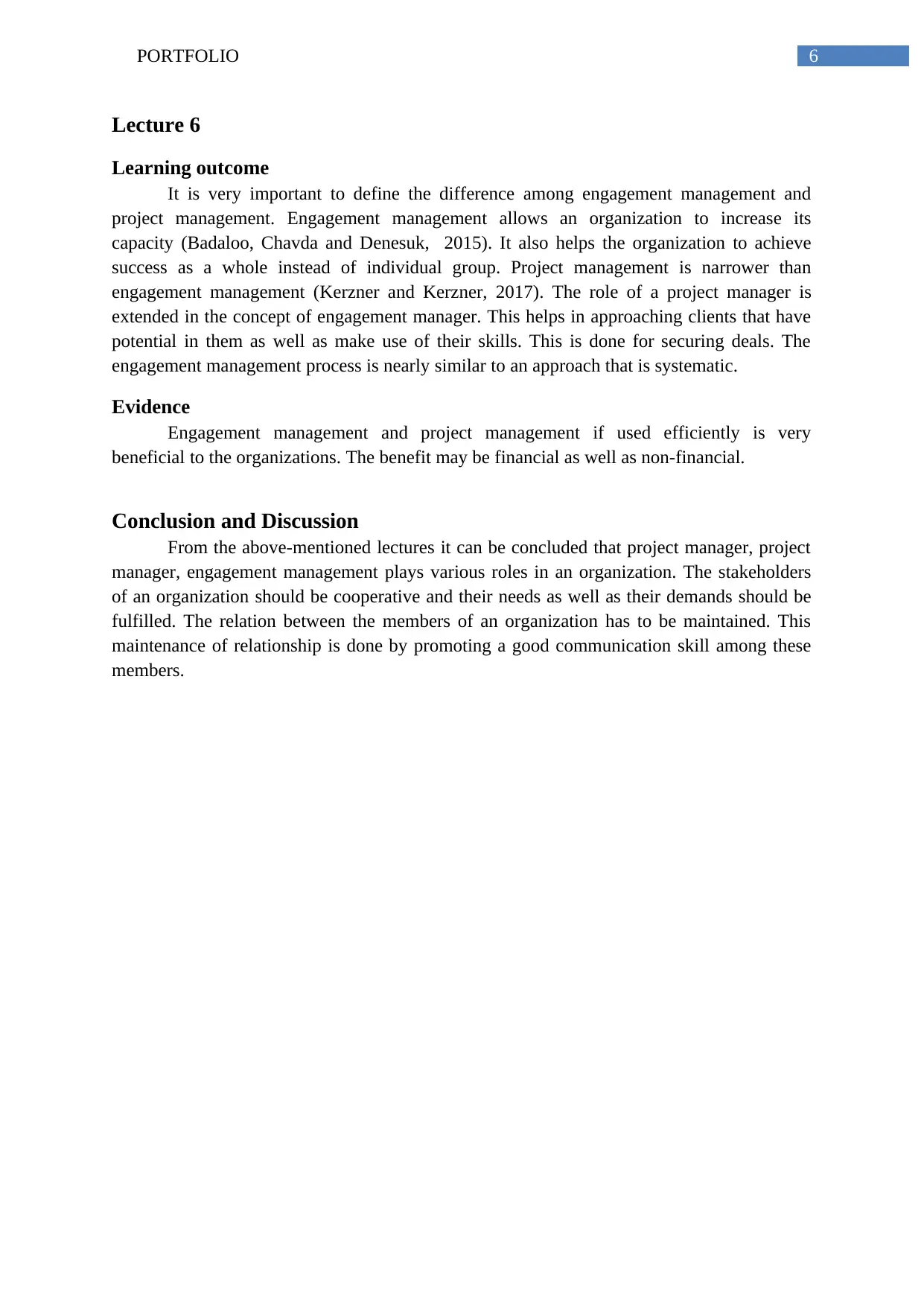
6PORTFOLIO
Lecture 6
Learning outcome
It is very important to define the difference among engagement management and
project management. Engagement management allows an organization to increase its
capacity (Badaloo, Chavda and Denesuk, 2015). It also helps the organization to achieve
success as a whole instead of individual group. Project management is narrower than
engagement management (Kerzner and Kerzner, 2017). The role of a project manager is
extended in the concept of engagement manager. This helps in approaching clients that have
potential in them as well as make use of their skills. This is done for securing deals. The
engagement management process is nearly similar to an approach that is systematic.
Evidence
Engagement management and project management if used efficiently is very
beneficial to the organizations. The benefit may be financial as well as non-financial.
Conclusion and Discussion
From the above-mentioned lectures it can be concluded that project manager, project
manager, engagement management plays various roles in an organization. The stakeholders
of an organization should be cooperative and their needs as well as their demands should be
fulfilled. The relation between the members of an organization has to be maintained. This
maintenance of relationship is done by promoting a good communication skill among these
members.
Lecture 6
Learning outcome
It is very important to define the difference among engagement management and
project management. Engagement management allows an organization to increase its
capacity (Badaloo, Chavda and Denesuk, 2015). It also helps the organization to achieve
success as a whole instead of individual group. Project management is narrower than
engagement management (Kerzner and Kerzner, 2017). The role of a project manager is
extended in the concept of engagement manager. This helps in approaching clients that have
potential in them as well as make use of their skills. This is done for securing deals. The
engagement management process is nearly similar to an approach that is systematic.
Evidence
Engagement management and project management if used efficiently is very
beneficial to the organizations. The benefit may be financial as well as non-financial.
Conclusion and Discussion
From the above-mentioned lectures it can be concluded that project manager, project
manager, engagement management plays various roles in an organization. The stakeholders
of an organization should be cooperative and their needs as well as their demands should be
fulfilled. The relation between the members of an organization has to be maintained. This
maintenance of relationship is done by promoting a good communication skill among these
members.
Paraphrase This Document
Need a fresh take? Get an instant paraphrase of this document with our AI Paraphraser
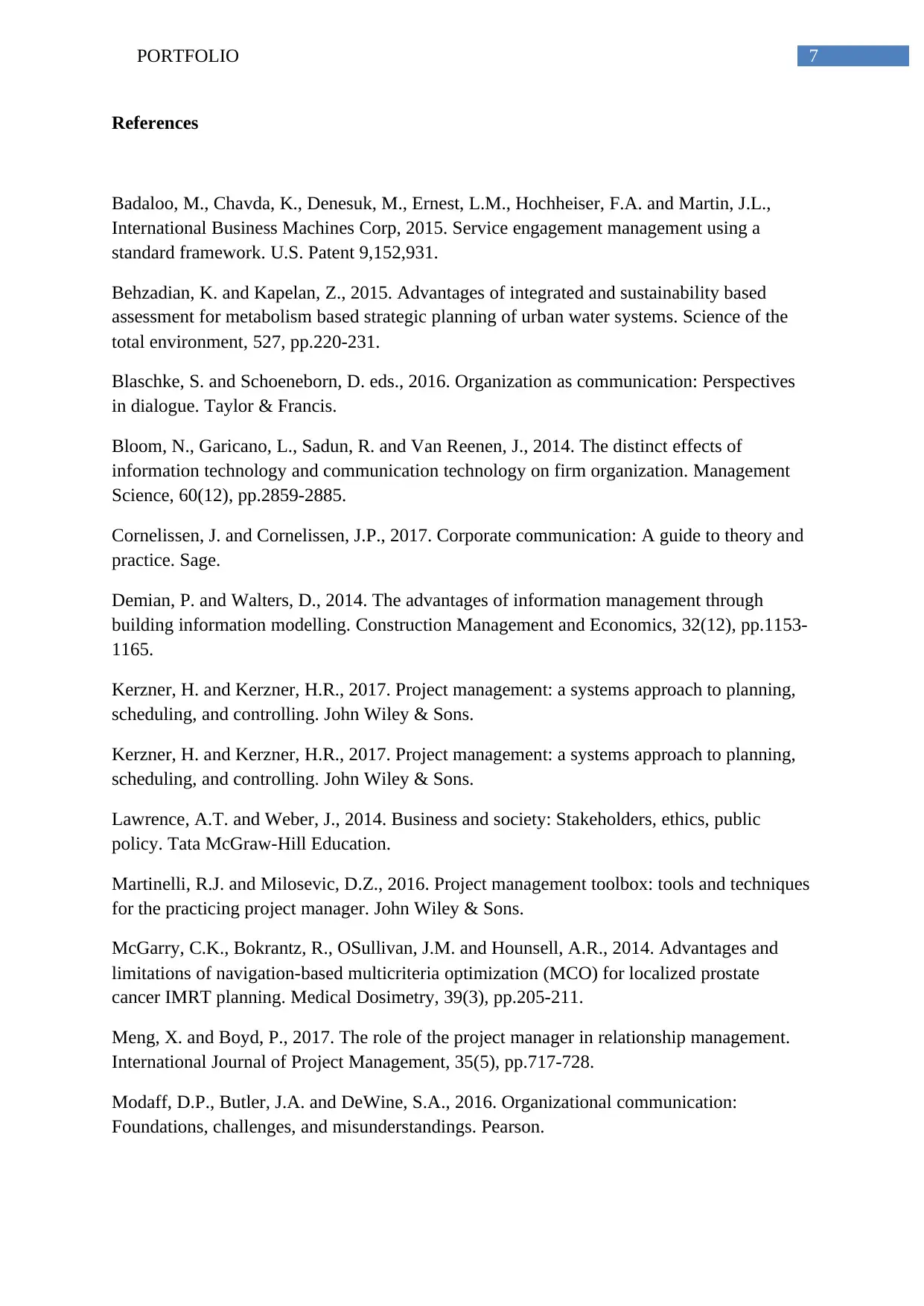
7PORTFOLIO
References
Badaloo, M., Chavda, K., Denesuk, M., Ernest, L.M., Hochheiser, F.A. and Martin, J.L.,
International Business Machines Corp, 2015. Service engagement management using a
standard framework. U.S. Patent 9,152,931.
Behzadian, K. and Kapelan, Z., 2015. Advantages of integrated and sustainability based
assessment for metabolism based strategic planning of urban water systems. Science of the
total environment, 527, pp.220-231.
Blaschke, S. and Schoeneborn, D. eds., 2016. Organization as communication: Perspectives
in dialogue. Taylor & Francis.
Bloom, N., Garicano, L., Sadun, R. and Van Reenen, J., 2014. The distinct effects of
information technology and communication technology on firm organization. Management
Science, 60(12), pp.2859-2885.
Cornelissen, J. and Cornelissen, J.P., 2017. Corporate communication: A guide to theory and
practice. Sage.
Demian, P. and Walters, D., 2014. The advantages of information management through
building information modelling. Construction Management and Economics, 32(12), pp.1153-
1165.
Kerzner, H. and Kerzner, H.R., 2017. Project management: a systems approach to planning,
scheduling, and controlling. John Wiley & Sons.
Kerzner, H. and Kerzner, H.R., 2017. Project management: a systems approach to planning,
scheduling, and controlling. John Wiley & Sons.
Lawrence, A.T. and Weber, J., 2014. Business and society: Stakeholders, ethics, public
policy. Tata McGraw-Hill Education.
Martinelli, R.J. and Milosevic, D.Z., 2016. Project management toolbox: tools and techniques
for the practicing project manager. John Wiley & Sons.
McGarry, C.K., Bokrantz, R., OSullivan, J.M. and Hounsell, A.R., 2014. Advantages and
limitations of navigation-based multicriteria optimization (MCO) for localized prostate
cancer IMRT planning. Medical Dosimetry, 39(3), pp.205-211.
Meng, X. and Boyd, P., 2017. The role of the project manager in relationship management.
International Journal of Project Management, 35(5), pp.717-728.
Modaff, D.P., Butler, J.A. and DeWine, S.A., 2016. Organizational communication:
Foundations, challenges, and misunderstandings. Pearson.
References
Badaloo, M., Chavda, K., Denesuk, M., Ernest, L.M., Hochheiser, F.A. and Martin, J.L.,
International Business Machines Corp, 2015. Service engagement management using a
standard framework. U.S. Patent 9,152,931.
Behzadian, K. and Kapelan, Z., 2015. Advantages of integrated and sustainability based
assessment for metabolism based strategic planning of urban water systems. Science of the
total environment, 527, pp.220-231.
Blaschke, S. and Schoeneborn, D. eds., 2016. Organization as communication: Perspectives
in dialogue. Taylor & Francis.
Bloom, N., Garicano, L., Sadun, R. and Van Reenen, J., 2014. The distinct effects of
information technology and communication technology on firm organization. Management
Science, 60(12), pp.2859-2885.
Cornelissen, J. and Cornelissen, J.P., 2017. Corporate communication: A guide to theory and
practice. Sage.
Demian, P. and Walters, D., 2014. The advantages of information management through
building information modelling. Construction Management and Economics, 32(12), pp.1153-
1165.
Kerzner, H. and Kerzner, H.R., 2017. Project management: a systems approach to planning,
scheduling, and controlling. John Wiley & Sons.
Kerzner, H. and Kerzner, H.R., 2017. Project management: a systems approach to planning,
scheduling, and controlling. John Wiley & Sons.
Lawrence, A.T. and Weber, J., 2014. Business and society: Stakeholders, ethics, public
policy. Tata McGraw-Hill Education.
Martinelli, R.J. and Milosevic, D.Z., 2016. Project management toolbox: tools and techniques
for the practicing project manager. John Wiley & Sons.
McGarry, C.K., Bokrantz, R., OSullivan, J.M. and Hounsell, A.R., 2014. Advantages and
limitations of navigation-based multicriteria optimization (MCO) for localized prostate
cancer IMRT planning. Medical Dosimetry, 39(3), pp.205-211.
Meng, X. and Boyd, P., 2017. The role of the project manager in relationship management.
International Journal of Project Management, 35(5), pp.717-728.
Modaff, D.P., Butler, J.A. and DeWine, S.A., 2016. Organizational communication:
Foundations, challenges, and misunderstandings. Pearson.
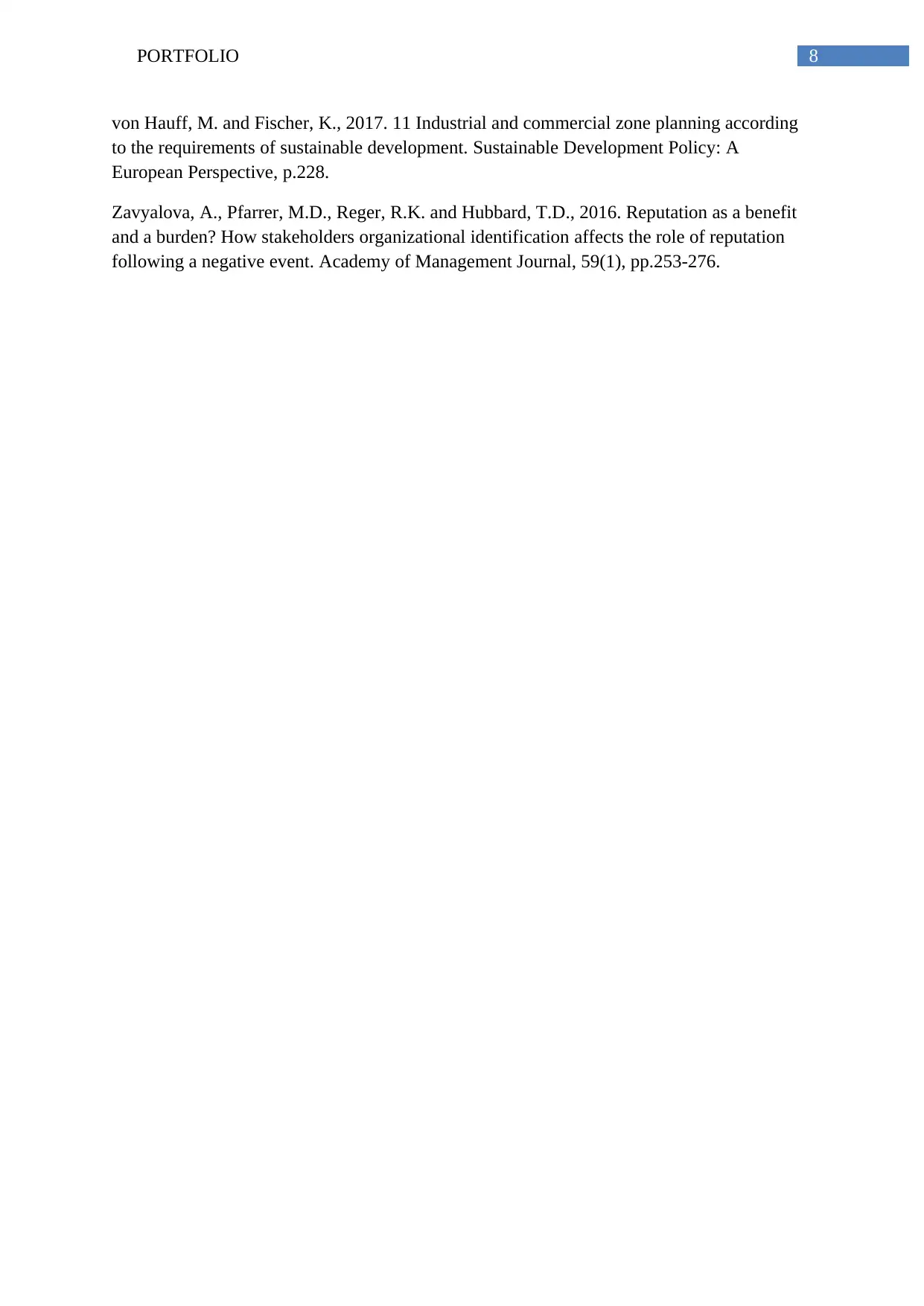
8PORTFOLIO
von Hauff, M. and Fischer, K., 2017. 11 Industrial and commercial zone planning according
to the requirements of sustainable development. Sustainable Development Policy: A
European Perspective, p.228.
Zavyalova, A., Pfarrer, M.D., Reger, R.K. and Hubbard, T.D., 2016. Reputation as a benefit
and a burden? How stakeholders organizational identification affects the role of reputation
following a negative event. Academy of Management Journal, 59(1), pp.253-276.
von Hauff, M. and Fischer, K., 2017. 11 Industrial and commercial zone planning according
to the requirements of sustainable development. Sustainable Development Policy: A
European Perspective, p.228.
Zavyalova, A., Pfarrer, M.D., Reger, R.K. and Hubbard, T.D., 2016. Reputation as a benefit
and a burden? How stakeholders organizational identification affects the role of reputation
following a negative event. Academy of Management Journal, 59(1), pp.253-276.
⊘ This is a preview!⊘
Do you want full access?
Subscribe today to unlock all pages.

Trusted by 1+ million students worldwide
1 out of 9
Related Documents
Your All-in-One AI-Powered Toolkit for Academic Success.
+13062052269
info@desklib.com
Available 24*7 on WhatsApp / Email
![[object Object]](/_next/static/media/star-bottom.7253800d.svg)
Unlock your academic potential
Copyright © 2020–2025 A2Z Services. All Rights Reserved. Developed and managed by ZUCOL.




